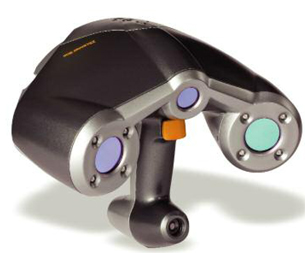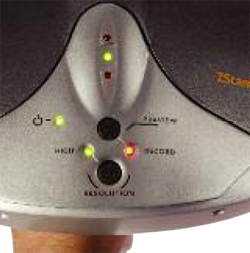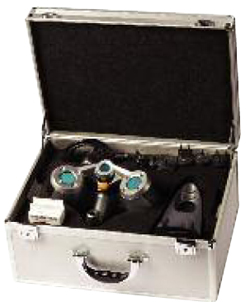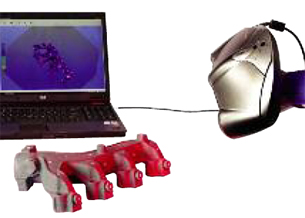Z Corporation’s ZScanner 800 Offers Speedy Precision
Z Corp's latest scanner moves digital shape capture to another level.
Latest News
July 2, 2008
By Al Dean
 Z Corporation’s ZScanner 800 uses three high-speed CCD cameras and a laser projection unitto triangulate its position froma series of targets randomly arranged on your part. |
Anyone involved in reverse engineering will tell you the ZScanner 800 is an intriguing tool. And there are several reasons for this. It is essentially a Creaform device, rebadged and with slightly redeveloped software from Z Corporation. While Creaform, of Levis, Quebec, has done a pretty good job of marketing the apparatus, the RE market is highly fragmented and there are dozens of devices from different manufacturers being used by engineers and data acquisition specialists — with no real clear winner in the space. Z Corporation, due to its success with ZPrinter 3D printers, offers a higher profile and resale channel with greater reach in the market than the smaller Canadian company.
Alongside the business aspects, the apparatus itself is interesting. We are all familiar with the wealth of noncontact scanning devices available, but two key factors make this one different. First, the device isn’t actually connected to anything other than a FireWire cable. Where other systems are fixed in space or attached to a measurement arm, the ZScanner differs by using high-speed CCD camera units (two in the case of the older 700, three for the 800) and a laser projection unit to triangulate its position from a series of targets randomly arranged on your part.
Second, the system tracks the ZScanner’s movement around the object it is scanning as it captures data. This gives the user several benefits.
 A preview button on top of the devicehelps orient you to the starting point.A new high-resolution button will improvescanning where details are important. |
How It Works
First up, the product you’re working on needs to be selectively dotted with small white reflective targets. These are key to the system’s self-positioning capability. They are used as reference points by the camera units to capture the position of the device in relation to the part. The physical form of the object is captured using a Class II laser mounted in the center of the unit that projects crosshairs. Where those crosshairs meet (or reflect from the surface of the object), the cameras capture the profile of laser lines projected onto the part many times per second, building the triangulated surface. The ZScanner 800 improves on the previous model with a maximum capture rate of 25,000 measurements per second whereas the ZScanner 700’s rate is 18,000.
The combination of these two input methods, along with some clever proprietary triangulation software, automatically captures the geometry of the part and the position of the unit. Assuming that everything else is set up correctly, the end result is a combination of hardware and software that will generate a polygon mesh in real-time.
This last point is key, as it’s the software that handles the bulk of the work and comes in two flavors.
 A sturdy carrying case protects the unitduring transportation. |
The standard software supplied with the ZScanner is ZScan and offers data capture and automated processing tools. For more complex data use, Geomagic software is the other option (see DE for a review of Geomagic Studio 10, May 2008). In the sales material for the device, Z Corporation is careful to point out that the system doesn’t create point clouds, but rather generates STL meshes on the fly, completely skipping point-cloud processing.
In Use
The ZScanner 800 is a nifty handheld device (a little heavier than the ZScanner 700 because of the extra high-resolution camera) and it requires very little calibration. If the system hasn’t been used in a while or has been banging around in the boot of your car, you simply position the device over a supplied calibration plate, pull the unit up, and it self-calibrates. To scan, you dot your part with the targets (the more random the better as it assists with pattern tracking) and you’re ready to start. You can use the preview button on the top of the device to reveal the spot you’re pointed at before you start.
Once ready, you press the trigger and start to pass the projected crosshairs over the surface of your object. The major differentiator and unique aspect of this device is its self-positioning nature: You move the unit around the object, rather than moving the object while the scanner remains in position — without using an arm. It does this by registering the position of the targets: As the system detects the first four, it triangulates and retains the position of the device. As you pass the scanner over, the laser captures the geometry and the scanner’s position is known by tracking these targets. If you lose position, you simply press the trigger and pass the laser over an already captured area to re-acquire its position. Plus, because the position of the scanner and its relation to the object can be tracked, it means you can move the object itself as well as the scanner — as long as the position can be maintained or reacquired, then you can turn an object over and scan the underside as well as internal details and such — something that is pretty unique.
 As you pass the scanner over the object, real-time feedback maintains the relative position of the scanner and you canwatch the object appear on your laptop screen. |
This is the workflow of the ZScanner 700, but what the ZScanner 800 brings to the table is higher resolution. To use this, you press the new high-resolution button on the top of the unit and rescan an area in which you need more detail. This decreases the resolution to 0.0019 in. Obviously, you need to spend a little more time scanning these areas to get a full description of the part, but the speed boost means this isn’t too much of a factor.
Where other systems have a postprocess-based workflow, with the ZScanner, the geometry is triangulated in real-time in the ZScan application. This application provides real-time feedback as to the position of the scanner and whether you’re in range. You can watch the object appear on a laptop screen as you scan.
To capture the geometry accurately the scanner needs to be passed over the object at normal (perpendicular) to its surface and at a range of around 10 inches. An onscreen gauge shows you how close you are and if you’re edging away — with green meaning “in range” and yellow to red meaning you’re either too close or too far away. It might sound a little complex, but the reality is that it took me about 30 seconds to get used to how the system works and how I could achieve the best scan — it really is that easy to use. It feels like you’re painting the part as you see it develop on your computer screen. Also, with its high accuracy, you can also now lock the view, allowing you to really concentrate on the features and details at hand.
I worked with a couple of parts and the ZScanner 800 captured the geometry very quickly. I’m told that a recent customer scanned a complete car in a matter of a few hours, exterior and interior, something that would have required a lot more work (to align separate scan sets) using other “fixed” systems.
Where next?
While the ZScan software is aimed at the most common tasks (reading geometry for replication with RP or into MCAD), you might want to extend the use of that data further. It is when you’re looking at inspection and further downstream use that the other software option makes sense. To assist completing these more complex scanning tasks, Z Corporation has an agreement with Geomagic to supply its reverse engineering software. This brings all of Geomagic’s knowledge and technology to bear to provide the user with more tools for repairing problematic data, aligning, merging, and processing separate scan sets into a complete model. What’s also interesting is that because of the increased accuracy and resolution of this device, it’s now moving from just the area of shape capture and into the realm of metrology and inspection. The ability to capture an entire part in a very short space of time is going to make this product very popular indeed.
As we said at the outset, the RE device market is emerging and as such, it’s one that’s highly fragmented — anyone that’s attended TCT, Euromold, Rapid, or any other show will know that there are umpteen of these devices, all using slightly different technology, all providing their own benefits and disadvantages — and I wouldn’t fancy the potential purchaser trying to make a quick decision. What it boils down to is whether the appliance you’re evaluating can do the job, not get in the way, and be effective for what you need to use it for.
If you’re looking for a system that allows you to capture both smaller parts and very large parts with a single device, then the ZScanner 700 wins. If you’re looking to work quickly and to a higher degree of accuracy, then the ZScanner 800 is the option for you.
While there are much more cost-effective systems available, typically, for that lower cost, you have to put up with a less-than-optimal workflow. What the ZScanners enable you to do is get a job done with minimal hassle so you can get on with the workflow or process at hand. With the introduction of the ZScanner 800, that will happen more quickly and with greater accuracy; it’s really a step forward for an already impressive solution.
More Info:
Z Corporation
Burlington, MA
zcorp.com
ZScanner 800 Specifications
> Weight: 2.75 lbs.
> Dimensions: 6.75 x 10.2 x 8.5 in.
> Sampling Speed: 25,000 measurements per second
> Laser: Class II (eye safe)
> XY Resolution: Up to 0.0015 in.
> Z Resolution: 0.0019 in.
> Data Transfer: FireWire
> Power Source: FireWire
Creaform
Levis, QUE
creaform3d.com
Geomagic
Research Triangle Park, NC
geomagic.com
Contributing Editor Al Dean is the editor at DEVELOP3D, a UK product development and manufacturing technology journal. Send comments about this article to [email protected].
Subscribe to our FREE magazine, FREE email newsletters or both!
Latest News
About the Author
DE’s editors contribute news and new product announcements to Digital Engineering.
Press releases may be sent to them via [email protected].






